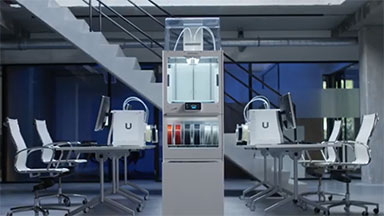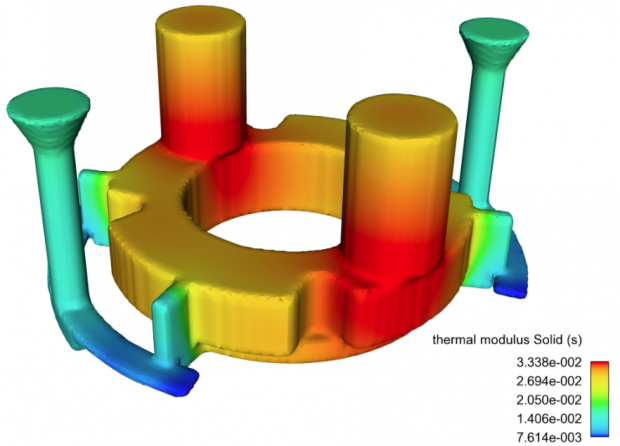
FLOW-3D CAST v5 now outputs the thermal modulus from solidification simulations. Image courtesy of Flow Science Inc.
Latest News
March 21, 2018
Flow Science calls version 5.0 of its FLOW-3D CAST metal casting simulation software “a major release.” This latest edition offers new tools for predicting casting defects that provide insights that shorten design cycles and reduce cost, according to the company. Among the developments in v5.0 highlighted by Flow Science are thermal modulus improvements and hot spot identification output for solidification simulations as well as filling defect tools for identifying trapped gases and predicting venting efficiency. Additionally, FLOW-3D CAST v5.0 sees faster and more robust pressure and stress solvers than its predecessors.
 FLOW-3D CAST v5 now outputs the thermal modulus from solidification simulations. Image courtesy of Flow Science Inc.
FLOW-3D CAST v5 now outputs the thermal modulus from solidification simulations. Image courtesy of Flow Science Inc.Flow Science reports that FLOW-3D CAST comes in Suites of relevant casting processes. Among these Suites are Permanent Mold, High Pressure Die Casting (HPDC), Low Pressure Sand Casting (LPSC) and Lost Foam. It explains that each Suite provides process-based workspaces that simplify simulation setup by allowing metal casters to choose the process they want to simulate.
Once users select a process, FLOW-3D CAST provides the appropriate process parameters, geometry types and industry defaults. For each process, the user interface only displays what is relevant to that particular process. The company calls this its What-You-See-Is-What-You-Need (WYSIWYN) interface.
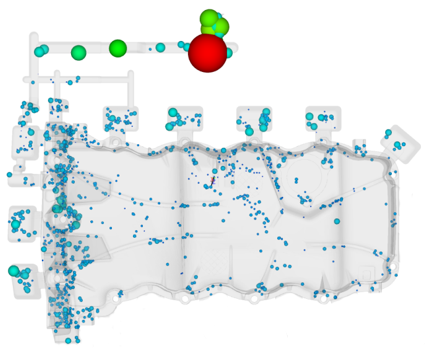 To help predict filling defects caused by entrapped gas, FLOW-3D CAST v5 sees new void particles that represent collapsed gas regions. At the end of filling, the final locations of the void particles indicate a potential defect due to air entrainment and/or oxides. Image courtesy of Flow Science Inc.
To help predict filling defects caused by entrapped gas, FLOW-3D CAST v5 sees new void particles that represent collapsed gas regions. At the end of filling, the final locations of the void particles indicate a potential defect due to air entrainment and/or oxides. Image courtesy of Flow Science Inc.By way of example, the Permanent Mold Suite offers such process workspaces as gravity die casting, low-pressure die casting (LPDC) and tilt pour casting. Likewise, the Sand Casting Suite includes processes such as gravity sand casting and low-pressure sand casting while the HPDC Suite includes everything relevant to high-pressure die casting, such as thermal stresses and deformations.
The company further adds that, within each process workspace, sub-processes like filling, solidification and cooling are connected simulations that run one after another. This operating characteristic is said to model the complete process from start to finish, as it would occur on the metal casting shop floor.
Users can also expand the process to include such steps as the complete movement and filling of the ladle by dipping it into the melt pool and transferring it to the shot sleeve or pour cup. For LPDC, process engineers can model the pressurization of the crucible and the flow of metal into the mold.
FLOW-3D CAST v5 debuts an output quantity called Hot Spots. Intended for use in mold design, Hot Spots can help users locate as well as size risers and then identify the potential for solidification-related defects, Flow Science says. Additionally, FLOW-3D CAST v5’s Thermal Modulus functionality, which is commonly used for sizing risers, has been enhanced so that now outputs from solidification simulations.
Flow Science reports that FLOW-3D CAST v5 makes it easier to identify filling defects caused by entrapped gas, thanks to the introduction of void particles that represent collapsed gas regions. Void particles behave like small bubbles and interact with the metal via drag and pressure forces, according to the company. Their size changes in response to the surrounding metal pressure, and their final location at the end of filling indicate a potential defect due to air entrainment and/or oxides.
A new Porosity Analysis tool debuts in the FlowSight post-processing tool set. It enables casters to identify porosity-related defects in real-world terms. Defects can now be identified by their net volume, largest linear extent, shape factor and total count.
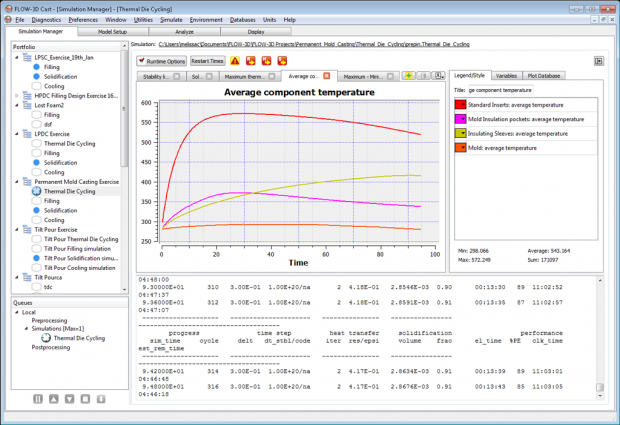 Beginning with version 5.0, FLOW-3D CAST users can configure plots then save their configurations to a database for subsequent simulations. Image courtesy of Flow Science Inc.
Beginning with version 5.0, FLOW-3D CAST users can configure plots then save their configurations to a database for subsequent simulations. Image courtesy of Flow Science Inc.FLOW-3D CAST v5 also sees more plotting capabilities in the Simulation Manager, including the ability to configure plots then save the configurations to a database for later reuse. Among the other v5 enhancements is a new feature that enables users to calculate the heat transfer coefficient between the spray fluid and the die surface dynamically based on the flow rate of the spray fluid at the nozzle. Additionally, two new Geometry Summary Views now provide table views of the geometry components and cooling channels. This enables users to see important settings at a glance and make changes as required.
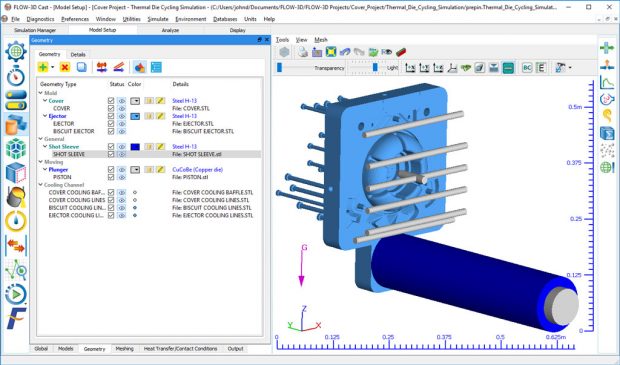 Flow Science has released version 5.0 of its FLOW-3D CAST metal casting simulation software. Shown here is a model setup workspace. Image courtesy of Flow Science Inc.
Flow Science has released version 5.0 of its FLOW-3D CAST metal casting simulation software. Shown here is a model setup workspace. Image courtesy of Flow Science Inc.“The release of FLOW-3D CAST v5 puts the power of the industry’s most accurate casting simulation tool into the hands of everyday users. Our new defect prediction tools, coupled with a more robust simulation engine, a redesigned What-You-See-Is-What-You-Need (WYSIWYN) interface and [the new] porosity analysis tool, make simulation a reality for every casting project,” says John Ditter, VP of Software Engineering at Flow Science, in the release announcement.
For more details on FLOW-3D CAST, click here.
Go here to learn all that’s new in FLOW-3D CAST v5.
Explore FLOW-3D CAST v5’s process suites.
Check out the Flow Science case study library.
See why DE‘s Editors selected FLOW-3D CAST v5 as their Pick of the Week.
Sources: Press materials received from the company and additional information gleaned from the company’s website.
Subscribe to our FREE magazine, FREE email newsletters or both!
Latest News
About the Author
Anthony J. Lockwood is Digital Engineering’s founding editor. He is now retired. Contact him via [email protected].
Follow DE




